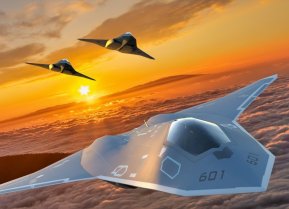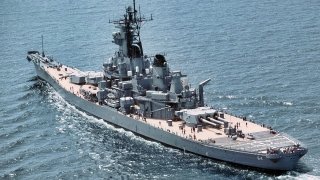North Korea Hit Iowa-Class Battleship USS Wisconsin with an Artillery Shell (No Damage)
North Korea fired at the distant USS Wisconsin, hitting the battle behemoth with a 155 mm shell. Despite this, the great warship was not damaged. In fact, she sustained no loss of life from the destructive impact.
The USS Wisconsin (BB-64), nicknamed “Big Wisky” by the sailors and Marines who adored her in the Korean War, is an Iowa-class battleship that was built during World War II and commissioned in 1944. The ship served in the Pacific theater during the war, participating in the battles of Iwo Jima and Okinawa.
Had the Allies followed through on their proposed invasion of the Japanese Home Islands, the Wisconsin, with her three powerful Mk 7-gun turrets, which could fire a devastating volley of 2,700-pound armor-piercing shells from up to 20 miles away, would have provided fire support for Allied forces.
Projecting Power with Battleships
The third of four Iowa-class battleships, the Wisconsin was not to be trifled with—even if she had been used in more of a support role rather than a starring role throughout the battlewagon’s long service.
Indeed, until Pearl Harbor, when the Navy was forced to shift away from the battleship in favor of the aircraft carrier, the battleship was the primary method of power projection for the U.S. Navy’s surface fleet. After Pearl Harbor, when the Japanese proved how decisive carriers could be in combat, the battleships remained important weapons in America’s arsenal.
They just weren’t the primary method of power projection.
After the war, USS Wisconsin was decommissioned and placed in the United States Navy reserve fleet. However, the ship was recommissioned in 1951 during the Korean War and saw action in the conflict, providing shore bombardment and fire support for ground troops.
It was here that the Wisconsin made a real name for itself.
A key aspect that is often lost upon those who support the flat top over the battlewagon is that, while the carrier can deploy airpower from farther distances, the battleship can come very close to an enemy target and unleash an insane amount of firepower—far more than what carriers can, for longer durations than can carriers. This was precisely what happened in the Korean War
Big Wisky Loses Her Temper
At Songjin, on March 15, 1952, “Big Wisky” was peppering entrenched North Korean positions ahead of a major landing by the U.S. Marines. The pounding she unleashed upon the North Koreans was so great that it collapsed a tunnel through which a North Korean supply train was running.
Collapsing the tunnel not only cut off the North Koreans from resupply operations but also prevented the North Korean force from getting much-needed reinforcements.
The North Koreans retaliated. They fired at the distant Wisconsin, hitting the battle behemoth with a 155 mm shell. Despite this, the great warship was not damaged. In fact, she sustained no loss of life from the destructive impact.
To compound matters for the North Korean attackers, the Wisconsin had identified the source of the 155 mm round. All nine of her 16-inch guns were targeted at the North Korean position and obliterated it. To be clear, the 16-inch guns fired 406 mm shells. So, that should indicate how much more powerful the Wisconsin was compared to fixed North Korean emplacements on land.
One of the other U.S. Navy warships accompanying “Big Wisky” supposedly aimed its signal lamp at the Wisconsin and chided “Temper, Temper.” Thus, the legend of the Wisconsin and her legendary temper while in battle became ingrained in the annals of U.S. Naval wartime history. And it would forever solidify the place of the battleship as a potent weapon of war. A platform that, despite its age, would serve for most of the twentieth century (and some today argue it could be modernized and serve again).
Big Wisky was again decommissioned in 1958.

The Battlewagon That Just Won’t Quit
She was once more brought back into service in 1986, as part of President Ronald Reagan’s effort to rebuild the U.S. Navy. The ship underwent modernization and served in Operation Desert Storm in 1991, where it fired its guns in combat for the first time since the Korean War. Along with its sister battleship, the USS Missouri, the two battlewagons fired more than 1 million pounds of ordnance at Iraqi military targets—setting more records for the storied warship.
Today, the USS Wisconsin is a museum ship moored at Nauticus, a maritime museum in Norfolk, Virginia. The ship is open to the public for tours and is maintained by a dedicated group of volunteers. Visitors can explore the ship’s interior, including the bridge, engine room, and gun turrets, and learn about its history and service during World War II, the Korean War, and Operation Desert Storm.
Standing there, on the decks of such a historical warship, one can almost feel the tremble that her once deafening guns let out—and the trembling those potent guns caused in the hearts of her enemies.
About the author
Brandon J. Weichert, a National Interest national security analyst, is a former Congressional staffer and geopolitical analyst who is a contributor at The Washington Times, the Asia Times, and The-Pipeline. He is the author of Winning Space: How America Remains a Superpower, Biohacked: China’s Race to Control Life, and The Shadow War: Iran’s Quest for Supremacy. His next book, A Disaster of Our Own Making: How the West Lost Ukraine, is due October 22 from Encounter Books. Weichert can be followed via Twitter @WeTheBrandon.


